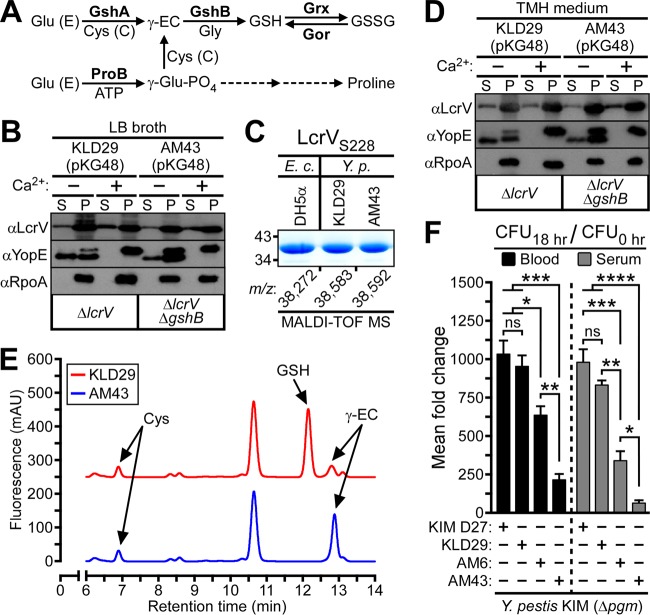FIG 5 .
Extracellular glutathione modifies secreted LcrV and promotes Y. pestis survival in blood. (A) Pathways of glutathione biosynthesis in E. coli. Glu (E), glutamic acid; Cys (C), cysteine; GshA, γ-glutamylcysteine synthetase; GshB, glutathione synthetase; ProB, γ-glutamyl kinase; γ-EC, γ-glutamylcysteine; GSH, glutathione; GSSG, glutathione disulfide; Gor, glutathione reductase; Grx, glutaredoxin; γ-glutamyl-PO4, γ-glutamyl phosphate. (B) Y. pestis KLD29 ΔlcrV lcrVS228(pKG48) and AM43 ΔlcrV ΔgshB lcrVS228(pKG48) were grown at 37°C in LB broth, in either the presence or absence of calcium ions (Ca2+), and assayed for type III secretion by immunoblotting; proteins secreted into the supernatant (S) were separated from intact bacteria (P) by centrifugation. (C) Y. pestis and E. coli strains expressing LcrVS228 (pKG48) were propagated in LB broth. LcrV was purified from Y. pestis supernatants (LcrVS228) or E. coli extracts (rLcrVS228), visualized by Coomassie-stained SDS-PAGE, and analyzed by MALDI-TOF MS to reveal the m/z of each LcrVS228 purification sample. (D) Y. pestis strains were analyzed for calcium-regulated type III secretion in TMH medium. (E) Partial HPLC chromatograms of LMW thiol-mBBr derivatives extracted from Y. pestis cultures grown to the stationary phase in TMH medium. Peaks corresponding to Cys, GSH, and γ-EC were assigned on the basis of retention time by comparison to a chromatogram of thiol standards. (F) Approximately 105 CFU of Y. pestis KIM D27 lcrV, KLD29 ΔlcrV, AM6 lcrVC273A, or AM43 ΔlcrV ΔgshB was inoculated into 4 ml of defibrinated sheep blood or heat-inactivated sheep serum. Culture aliquots were removed before and after 18 h of growth at 37°C and plated on LB agar to enumerate bacterial load. Y. pestis growth was calculated as the mean fold increase in bacteria at the time of inoculation (CFU0 h) to bacteria recovered after the 37°C incubation (CFU18 h). Data are means ± SEM (n = 3). *, P < 0.05, **, P < 0.01, ***, P < 0.001, and ****, P < 0.0001, and ns, not significant, by one-way ANOVA with Tukey’s multiple-comparison posttest.

